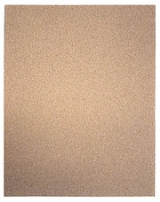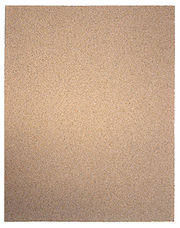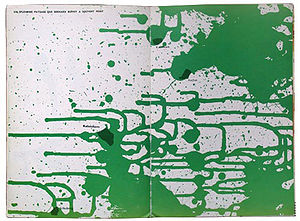
Mémoires
Encyclopedia

Asger Jorn
Asger Oluf Jorn was a Danish painter, sculptor, ceramic artist, and author. He was a founding member of the avant-garde movement COBRA and the Situationist International...
in collaboration with the French artist and theorist Guy Debord
Guy Debord
Guy Ernest Debord was a French Marxist theorist, writer, filmmaker, member of the Letterist International, founder of a Letterist faction, and founding member of the Situationist International . He was also briefly a member of Socialisme ou Barbarie.-Early Life:Guy Debord was born in Paris in 1931...
. Printed in 1959, it is the second of two collaborative books by the two men whilst they were both members of the Situationist International.
Psychogeography and détournement

Psychogeography
Psychogeography was defined in 1955 by Guy Debord as "the study of the precise laws and specific effects of the geographical environment, consciously organized or not, on the emotions and behavior of individuals." Another definition is "a whole toy box full of playful, inventive strategies for...
, detailing a period in Debord's life when he was in the process of leaving the Lettrists, setting up Lettrism International, and showing his 'first masterpiece', Hurlements en Faveur de Sade (Howling In Favour Of Sade
Marquis de Sade
Donatien Alphonse François, Marquis de Sade was a French aristocrat, revolutionary politician, philosopher, and writer famous for his libertine sexuality and lifestyle...
), a film devoid of imagery that played white when people were talking on the soundtrack and black during the lengthy silences between.
Credited to Guy-Ernest Debord, with structures portantes ('load-bearing structures') by Asger Jorn, the book contains 64 pages divided into three sections. The first section is called 'June 1952', and starts with a quote from Marx:
Let the dead bury the dead, and mourn them.... our fate will be to become the first living people to enter the new life.
The second section, 'December 1952', quotes Huizinga
Huizinga
Huizinga can refer to the following people:*Ilse Huizinga, Dutch singer*Johan Huizinga, Dutch historian*Mark Huizinga, Dutch Olympic athlete*Tineke Huizinga, Dutch politician...
, and the third, 'September 1953', quotes Soubise
Soubise
Soubise can refer to:* Soubise sauce, a béchamel-based sauce containing strained or puréed onions* Soubise, a commune of the Charente-Maritime département, in France* Benjamin de Rohan, duc de Soubise , Huguenot leader...
.
The work contains two separate layers. The first is printed with black ink, reproducing found text and graphics taken from newspapers and magazines. The second layer is printed using coloured inks, splashed across the pages. These sometimes connect images and text, sometimes cover them, and sometimes are seemingly unconnected. The black layer contains fragments of text, maps of Paris and London, illustrations of siege warfare, cheap reproductions of old masters and questions such as 'How do you feel about the world at the moment, Sir?' The coloured layer contains freefloating ink splashes, lines created by a matchstick loaded in ink, and a Rorschach
Rorschach inkblot test
The Rorschach test is a psychological test in which subjects' perceptions of inkblots are recorded and then analyzed using psychological interpretation, complex algorithms, or both. Some psychologists use this test to examine a person's personality characteristics and emotional functioning...
inkblob.
Other pages deal with more personal themes, including a cartoon of the first showing of his film Hurlements en Faveur de Sade, with comments for and against, and references to Dérive
Dérive
In psychogeography, a dérive is an unplanned journey through a landscape, usually urban, where an individual travels where the subtle aesthetic contours of the surrounding architecture and geography subconsciously direct them with the ultimate goal of encountering an entirely new and authentic...
, which would become known as Situationist Drift, the habit of walking aimlessly through a city in an attempt to find its spirit. Détournement
Detournement
A détournement is a technique developed in the 1950s by the Letterist International, and consist in "turning expressions of the capitalist system against itself." Détournement was prominently used to set up subversive political pranks, an influential tactic called situationist prank that was...
('diversion' or 'disruption') is also employed in the book to disorient the reader by creating startling collaged juxtapositions. Originally deriving from Dada
Dada
Dada or Dadaism is a cultural movement that began in Zurich, Switzerland, during World War I and peaked from 1916 to 1922. The movement primarily involved visual arts, literature—poetry, art manifestoes, art theory—theatre, and graphic design, and concentrated its anti-war politics through a...
, détournement would become a key situationist strategy.
The last page is an orange swirl, above which reads the single sentence 'I wanted to speak the beautiful language of my century.'
Auto-destruction: the sandpaper cover
The book is most famous for its cover, a dust jacket made of heavy-grade sandpaperSandpaper
Sandpaper, also known as glasspaper, is a heavy paper with abrasive material attached to its surface.Sandpaper is part of the "coated abrasives" family of abrasive products. It is used to remove small amounts of material from surfaces, either to make them smoother , to remove a layer of material...
. Usually credited to Debord, the sleeve was actually conceived in a conversation between Jorn and the printer, V.O. Permild:
[Permild:] Long had [Jorn] asked me, if I couldn’t find an unconventional material for the book cover. Preferably some sticky asphalt or perhaps glass wool. Kiddingly, he wanted, that by looking at people, you should be able to tell whether or not they had had the book in their hands. He acquiesced by my final suggestion: sandpaper (flint) nr. 2: ‘Fine. Can you imagine the result when the book lies on a blank polished mahogany table, or when it's inserted or taken out of the bookshelf. It planes shavings off the neighbour's desert goat.
Fin de Copenhague

Copenhagen
Copenhagen is the capital and largest city of Denmark, with an urban population of 1,199,224 and a metropolitan population of 1,930,260 . With the completion of the transnational Øresund Bridge in 2000, Copenhagen has become the centre of the increasingly integrating Øresund Region...
, the book was published by Jorn's Edition Bauhaus Imaginiste
International Movement for an Imaginist Bauhaus
The International Movement for an Imaginist Bauhaus was a small European avant-garde artistic tendency that arose out of the breakup of COBRA, and was initiated by contact between former COBRA member Asger Jorn and Enrico Baj and Sergio Dangelo of the Nuclear Art Movement.-Timeline:*December 1953:...
in May 1957, a few months before this group amalgamated with the Lettrist International to create the Situationists.
In many ways very similar to the later book, the colour layers are more exuberant, the text more pointed. One page, for instance, asks in English:
What do you want? Better and cheaper food? Lots of new clothes? A dream home with all the latest comforts and labour saving devices? A new car . . . a motor launch . . . a light aircraft of your own? Whatever you want, it's coming your way - plus greater leisure for enjoying it all. With electronics, automation and nuclear energy, we are entering on the new Industrial Revolution which will supply our every need, easily . . . quickly . . . cheaply . . . abundantly.
Other pages include text in French, German, and Danish; illustrations of whisky bottles beer bottles and cigarettes; aeroplanes and ocean going liners; cartoons of well dressed men and pretty girls and various maps of copenhagen. One page declares, 'There's No Whiteness....Viva Free Algeria!' Each page is then covered with a second layer of coloured ink drops and drips, most of which go right to left, emphasising the direction of the book from beginning to end.
The book ends with the text:
Hurry! Hurry! Hurry! Tell us in not more than 250 words why your girl is the sweetest girl in town.
Methods of production
Having just arrived in Copenhagen, Jorn and Debord rushed into a newsagents, stole a huge amount of magazines and newspapers, and spent a drunken afternoon collaging elements together. The next day they arrived at the printers with 32 collages, which were transferred to lithographic plates. Jorn then sat at the top of a ladder over the zinc plates, dropping cup after cup of Indian ink onto them. The plates were then etched and printed over the black texts and images.The cover was a heavily embossed image of an advertisement for a razor blade.
The spectacle
The situationist concept of the spectacleSpectacle (Situationism)
The spectacle is a central notion in the Situationist theory developed by Guy Debord. Guy Debord's 1967 book, The Society of the Spectacle, attempted to provide the Situationist International with a Marxian critical theory...
runs through both books; represented by the newspapers and magazine collage elements, the collage and ink (détournement) used to disrupt the text represents a strategy to see the city as it really is, rather than as charted in maps and signposts.
'The spectacle epitomises the prevailing model of social life. It is the omnipresent celebration of a choice already made in the sphere of production, and the consummate result of that choice. In form as in content the spectacle serves as total justification for the conditions and aims of the existing system.' Guy Debord

